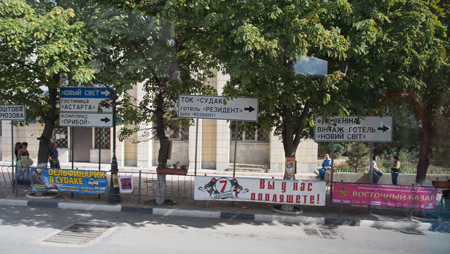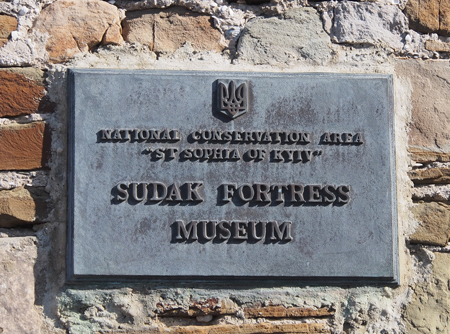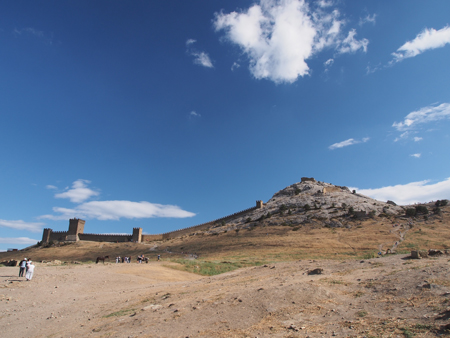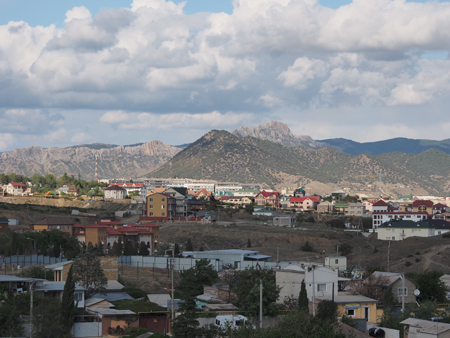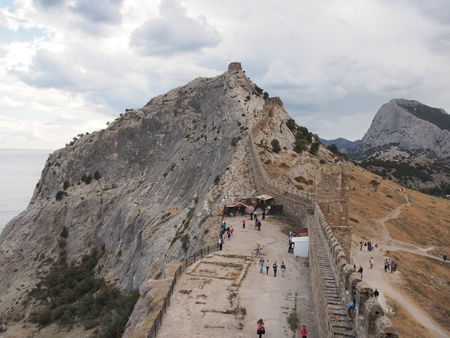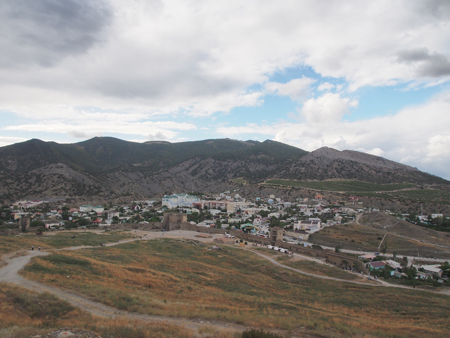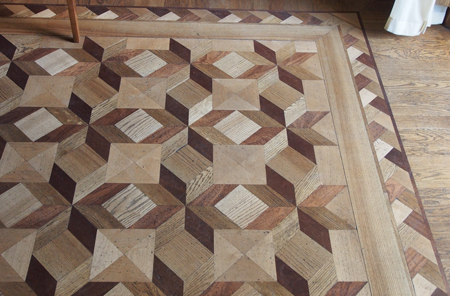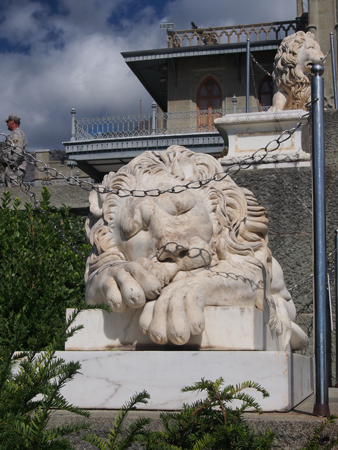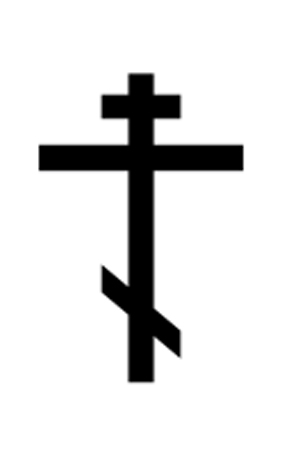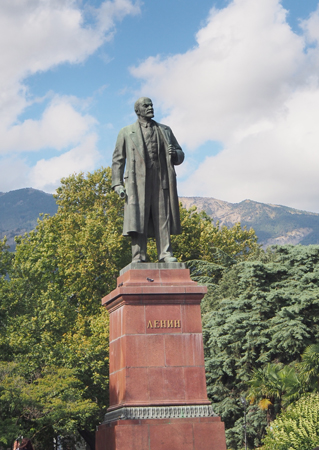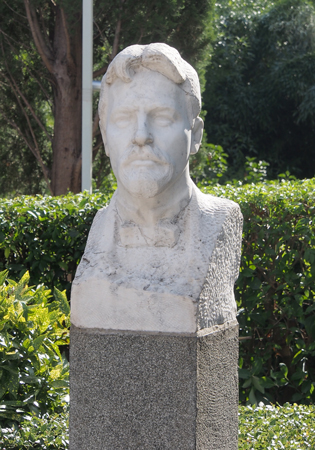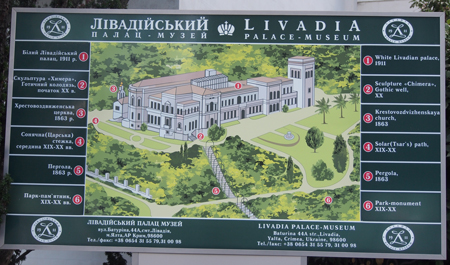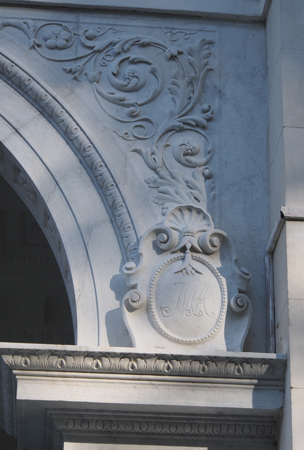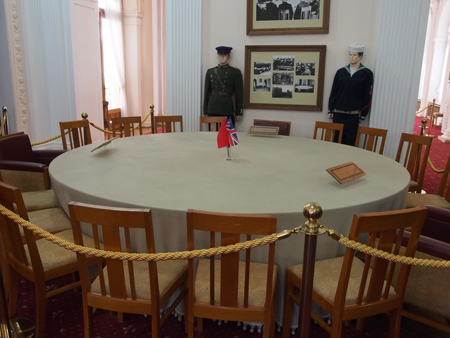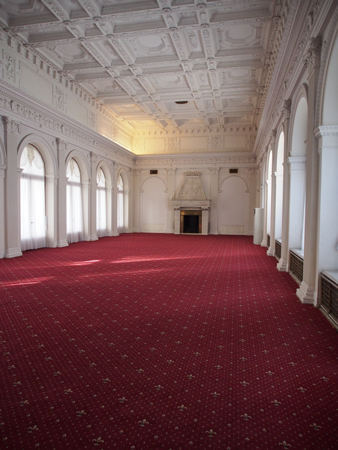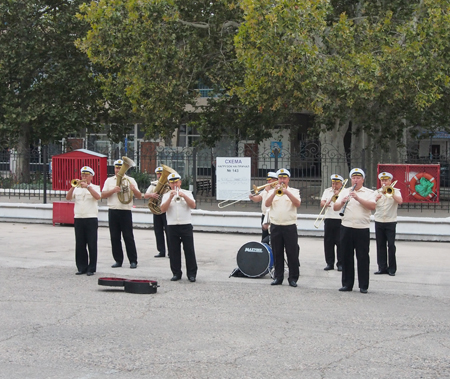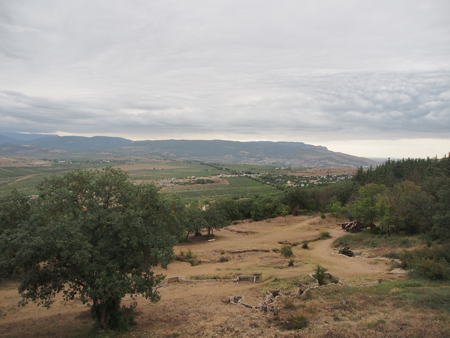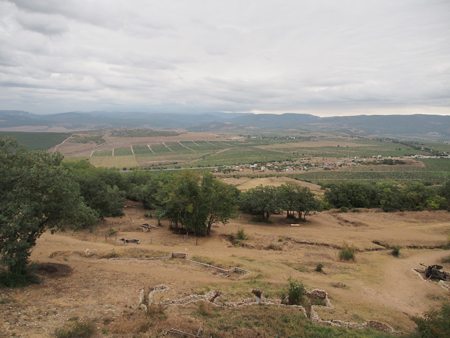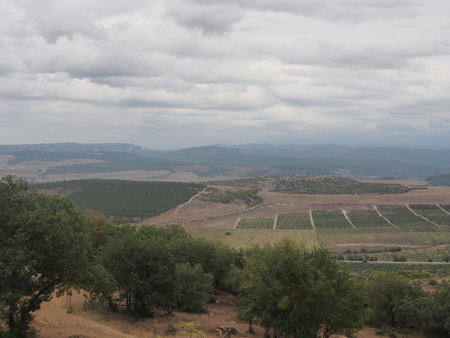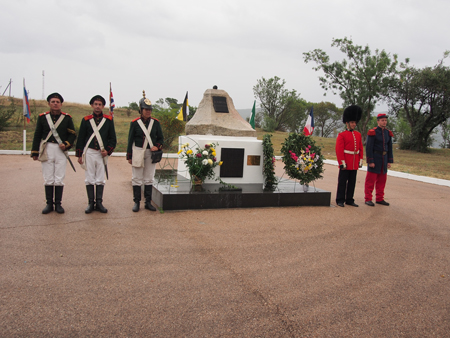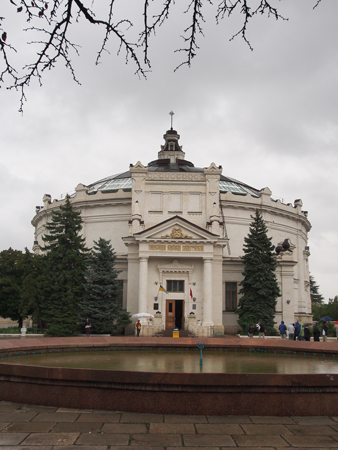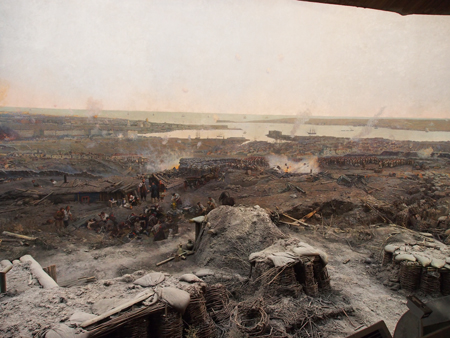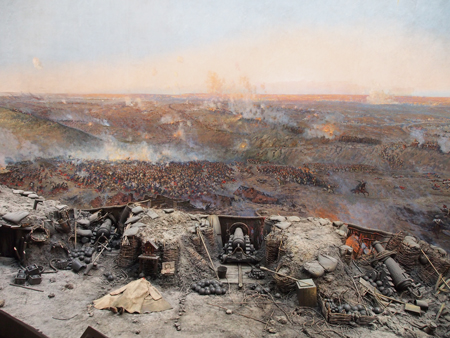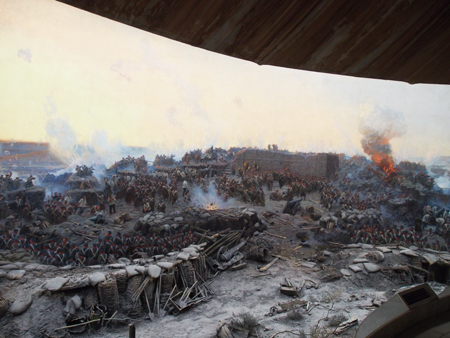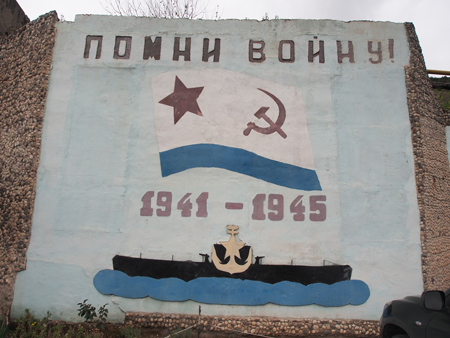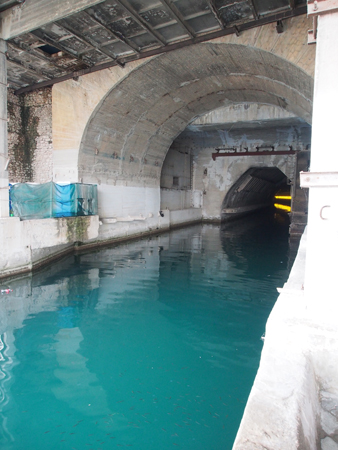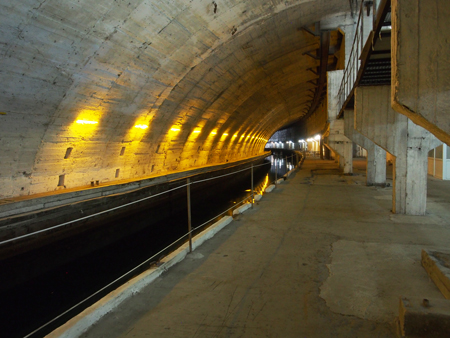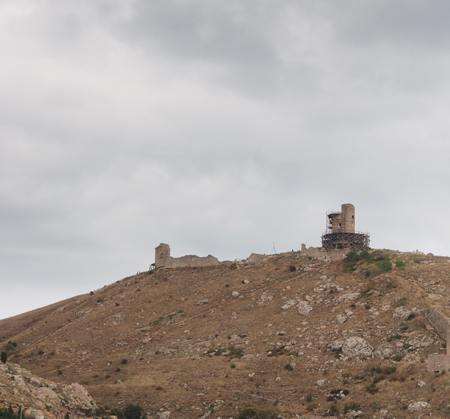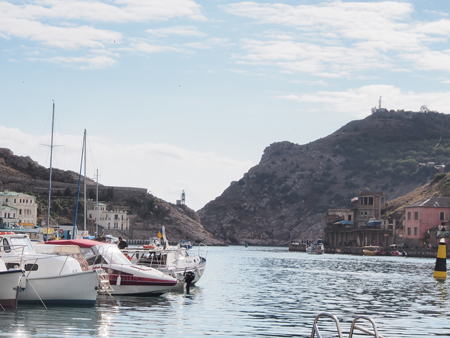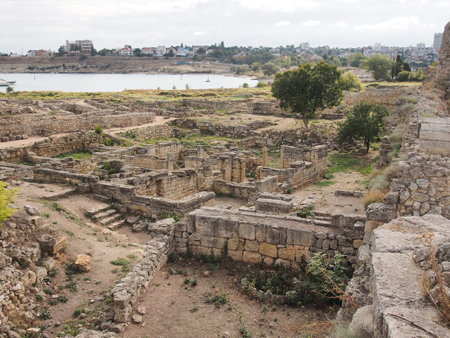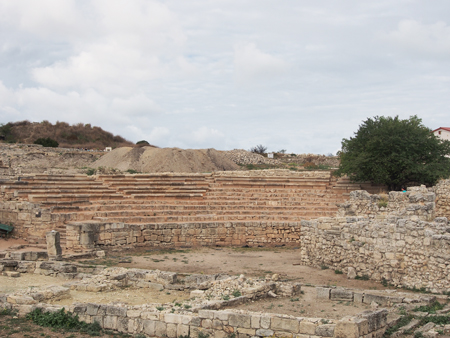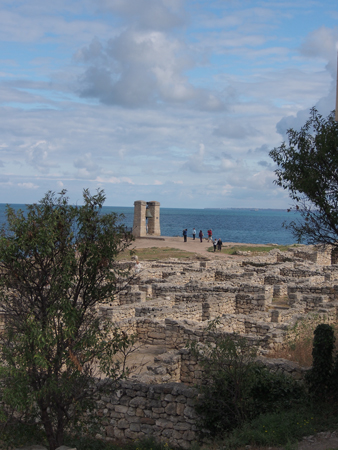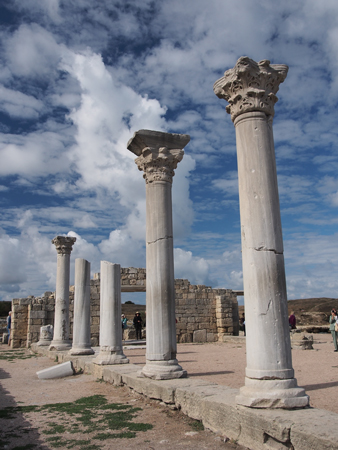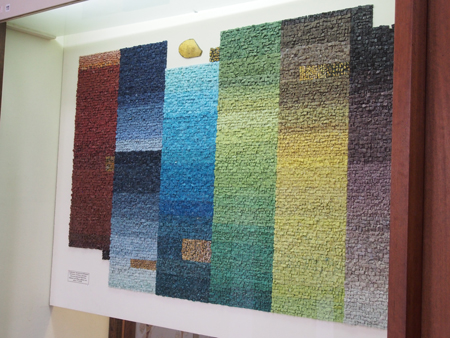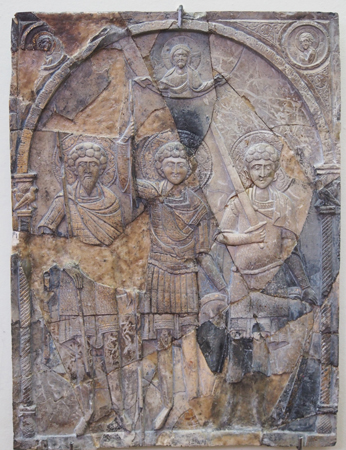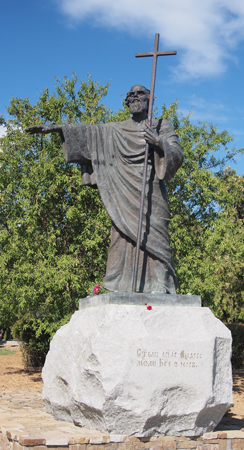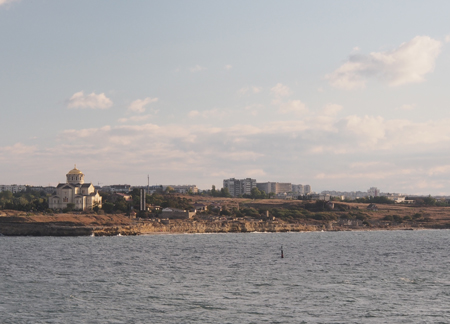Thurs., 9/5/13 – Feodosiya, Ukraine
We docked in Feodosiya, Ukraine at 11:30 AM. Feodosiya is on the east side of the Crimean Peninsula and was established by Greek sailors. In the 15th c. Crimea became part of the Ottoman Empire and had a large slave trade market. Slaves were captured and sold to Europe and the Middle East. The Nazis destroyed most of Feodosiya during WW II and after the war it fell to Russia and Communism. The fertile land was organized into productive collective farms to help feed Russia. In 1991 the Ukraine was freed from Russian control but for the first three years it suffered economic decline due largely to lack of organization. The Ukraine still has Russian as its first language. (Perhaps, explaining some of the current problems.)
Our afternoon tour was a long bus ride (78 km) to Sudak and a visit to the 13th c. Genoese built fortress there. The Genoese had set up thriving commerce along the Silk Road to China and Central Asia and needed to defend their trade ports. The fortress at Sudak is a UNESCO site. It is a sandstone structure built by Tartar craftsmen with 6 ½-foot thick walls, 18 towers (10 of which remain), and a wall to the top of a rock peak. (Sudak links: Information, photos)
Our local guide wasted time and did not tell us which way to head so we only had 40 minutes to explore. We were not pleased. He likes to hear himself talk and does not give a logical presentation. Unfortunately, he is supposed to be our guide for the next three days in the Ukraine.
We drove through the grape vineyards around town and then into the hardwood forests of the lower Crimean Mountains. Many things can grow here in the Steppes, which has rich black soil. Feodosiya is not an impressive city. It has ugly square buildings without decorations and narrow streets. It is conjectured that the Plague started in Feodosiya and spread to Europe along the trade routes killing 6 million people.
Flag of Ukraine
|
|
Signs in Ukrainian and Russian - both Cyrillic, but different |
|
Sudak Fortress
|
View of the mountains from Sudak Fortress |
Sudak Fortress
|
Sudak Fortress wall and entrance |
Fri., 9/6/13 – Yalta, Ukraine
This morning as we disembarked the ship we were greeted with music from a brass band. A few ports do this and it really makes us feel welcome but it is probably our tourist dollars they are happy to see. Yalta, Ukraine is a 19th c. town that became a fashionable resort for the Russian aristocracy and gentry. Leo Tolstoy spent summers here and Anton Chekhov bought a house and garden here and lived in it from 1898 to 1902. Yalta is the setting for his short story, “The Lady with the Dog.” Czar Nicholas II built a palace here.
Our morning tour was to Vorontsov Palace in Alupka. It was built among stunning red cliffs and with gardens down to the sea. The palace is a blend of architectures incorporating Scottish castle designs and Moorish Alhambra effects. Churchill stayed here during the 1945 Yalta Conference. Outside, the Moorish façade facing the sea has a courtyard and steps with six lions. One lion is referred to as the Churchill lion because he stated it looked like him. There is an interesting strawberry arbutus tree with rosy bark and a fruit that looks and smells like a strawberry.
Mountains above Vorontsov Palace
|
Wood inlay floor at Vorontsov Palace |
Fireplace in Vorontsov Palace |
Churchill's Lion - said to resemble him
|
From Alupka we drove to a photo stop to look at the Swallow’s Nest Castle. It is a fairy tale castle built in 1912 out on a cliff 130 feet above the sea and is the symbol for the city of Yalta. The last earthquake in the 1990’s almost sent the castle into the sea but the cliff has been stabilized. We also stopped at a pretty Armenian-style Archangel Michael Russian Orthodox Church, built from 2005 to 2006. The iconostasis is clean and bright. There is a statue of Archangel Michael outside. |
Swallow's Nest Castle
|
Archangel Michael Russian Orthodox Church
|
Iconostasis in the Archangel Michael Russian Orthodox Church
|
The Orthodox, Byzantine or Russian (Orthodox) Cross, also known as the Suppedaneum cross, is a variation of the Christian cross, commonly found in Eastern Orthodox Churches, as well as the Eastern Catholic Churches of Byzantine rite and the Society for Eastern Rite Anglicanism. The cross has three horizontal crossbeams—the top represents the plate inscribed with INRI, and the bottom, a footrest. In the Russian Orthodox tradition, the lower beam is slanted: the side to Christ's right is usually higher. This is because the footrest slants upward toward penitent thief St. Dismas, who was crucified on Jesus' right, and downward toward impenitent thief Gestas. (From Wikipedia)
|
Russian Orthodox cross
|
In the afternoon we were driven to the home of Anton Chekhov – the White Dacha. He had TB and thought the Crimean climate would benefit him. His two-story “cottage” had gardens with a brook running through it. Chekhov entertained Tolstoy, Gorky, and Rachmaninov at his home. |
Statue of Lenin
|
Interesting sign - in Ukrainian
|
Anton Chekhov |
Next we drove to Livadia Palace, built in 1911 for Czar Nicholas II and his family as a summer place. The family traveled here by train for two days and then got on their 103-meter yacht to sail to Yalta, with 25 cars and several tons of goods (small wonder there was a Russian Revolution!). The palace was the site of the Yalta Conference with Roosevelt, Stalin, and Churchill from Feb. 4 to 11, 1945. We saw the conference table and the dining room where the meetings took place. The first floor is now a museum about the conference and the second floor is all about the czar’s family. In 1972, President Nixon was on his way to meet with Gorbachev and asked to visit Livadia Palace as an historical stop. The Russians cleaned it up, restored what they could and, as a result, the palace became a museum. On the second floor in a sitting room of the czarina three men sang us a Ukrainian song. Two of the men were monks selling a CD to support their monastery and the tenor was a Met singer from America on holiday in Yalta. Obviously they were very good.
|
|
|
Medallion for Anastasia
|
Yalta Conference table |
Dining room where the Yalta Conference took place
|
Sat., 9/7/13 – Sevastopol, Ukraine
We woke up this morning docked amongst Ukrainian and Russian naval ships. Sevastopol, Ukraine is a Russian naval base on the Black Sea and the Ukrainian navy has ships here as well. Because of the Russian naval presence and importance here, Sevastopol is 85% Russian. More than half of the cars have Russian license plates and Russians also come here for holidays. In 1783 Catherine the Great saw the importance of the natural deep-water (30 meters) cove as a navy base and the Russians have fought to occupy the Crimea ever since. In the Crimean War (1854 – 56), Russia fought the Turks and the French and the Brits foolishly joined in to keep control of their Mediterranean holdings from the Russians.
As we left the ship this morning we were serenaded by another brass band. Our morning tour took us to Sapoune Ridge to look out across the Balaclava Battlefield, the site of the ill-fated British cavalry charge, during the Crimean War, on 10/25/1854. We stood where Commander-in-Chief Lord Raglan watched the disaster unfold as his men rode into a cul-de-sac controlled on three sides by the Russian army. Tennyson immortalized this disaster in his poem, “The Charge of the Light Brigade.”
Welcoming brass band
|
Crimean Battlefield site - Balaclava Battlefield (foreground trenches are from WWII) |
Crimean Battlefield site - Balaclava Battlefield (foreground trenches are from WWII)
|
Crimean Battlefield site - Balaclava Battlefield (road that curves around the fields is the site of the charge of the Light Brigade, right under the enemies's hilltop location)
|
|
We stopped at the Monument Stone of Reconciliation and laid a wreath on the monument. Three people in old Russian uniforms stood on one side and a person in British and one in French uniform stood on the other side. We drove to the Panorama Hall where the 1855 Siege of Sevastopol, during the Crimean War, is depicted in a 377-foot long and 46-foot high painting. The foreground has 3-D paper mache replicas of Russian soldiers, their trenches, and redoubts. F. Roubaud painted the enormous canvas in 1905. The original painting was stolen during WWII and only scraps of the canvas survived. In the 1950’s, 19 painters reproduced the painting in this hall. We walked up and around the hall. The presentation made us feel we were looking at the real gory event.
|
Panorama Hall
|
Sevastopol Diorama |
Sevastopol Diorama
|
Sevastopol Diorama |
Sevastopol Diorama
|
After lunch on the ship we went on another tour to the Balaclava Harbor and the Cold War, top-secret, underground base for Russian submarines. The tunnels, made famous in a James Bond movie, are now a naval museum. We walked through the tunnels dug into the limestone hillside and along the canal running through the underground cave. The tunnels contained a dry dock and room to hide nine submarines capable of carrying nuclear missiles. The tunnels and canal had three sets of doors at each end: the first was three feet thick, could be closed in two minutes, and protected against possible explosions; the second would keep out water; and the third kept out dust and gas. In the caves were storage rooms for diesel fuel and an arsenal of nuclear warheads and torpedoes and mines. There was a command post and place to protect 1,000 men for many days.
|
Russian submarine base |
Russian submarine base
|
Russian submarine base - waterproof doors
|
Russian submarine base |
Cembalo Fortress
|
The very much hidden exit (entry) to the Black Sea |
Sevastopol
|
Sun., 9/8/13 – Sevastopol, Ukraine We walked around the site, which is only one-third uncovered, among the 2,000 seat theater, a 5th c. Christian basilica with marble columns, the foundations of houses, and tradesmen’s shops. In the 19th c. St. Vladimir Roman Catholic Cathedral was built within the city walls. It was a beautiful day and the sea was clear and turquoise and it was easy to see that these ruins were once a magnificent city.
|
Ruins at Chersonesos
|
Ruins at Chersonesos - Theater |
Ruins at Chersonesos - Bell of Chersonesos - a fog bell
|
Ruins at Chersonesos - Roman Basilica |
Ruins at Chersonesos - Roman Basilica
|
Archeological Museum - Stone tile mosaic |
Archeological Museum - stones used for the mosaic |
Archeological Museum
|
Archeological Museum - Amphora
|
Chersonesos - St. Vladimir Roman Catholic Cathedral |
Chersonesos - Statue of St. Vladimir
|
Sevastopol - Sailing away |
Chersonesos - Sailing away
|
|
| Return to Top | Return to Itinerary | Return to Trips page to view other trips | Return to Dreamcatcher Home Page |


